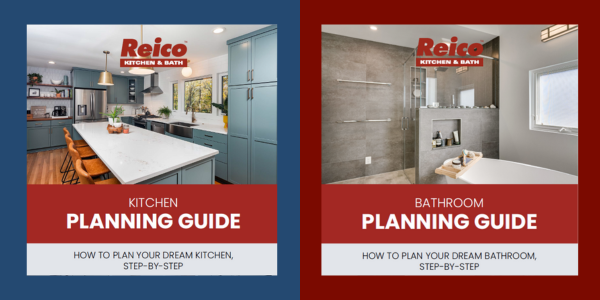If you love a good soak and want your new bathroom to reflect your style and your lifestyle, choosing the right bathtub is key. But with so many shapes, sizes and options, one of the first big decisions for your dream bathroom deciding between a freestanding tub or built in bathtub?
Let’s break down the key elements to understand and consider before making your choice.
1. What’s the Difference Between Freestanding and Built-In Tubs?
At a glance, the names say it all:
- A freestanding bathtub is finished on all sides. It sits independently in the room, often as a sculptural centerpiece. Freestanding bathtubs can rest on a pedestal, sit directly on the floor, or stand on claw feet.
- A built-in bathtub is installed within a structure — usually an alcove or in a corner — and are often surrounded by one, two, or three walls. Styles range from built-in alcove tubs with a finished front (apron) to drop-in and molded models surrounded by tile, stone, or custom panels.
Both types of bathtubs can be beautiful and functional, but how you use your bathroom and how much space you have may guide you toward one over the other.
2. Do You Want the Tub to Make a Statement?
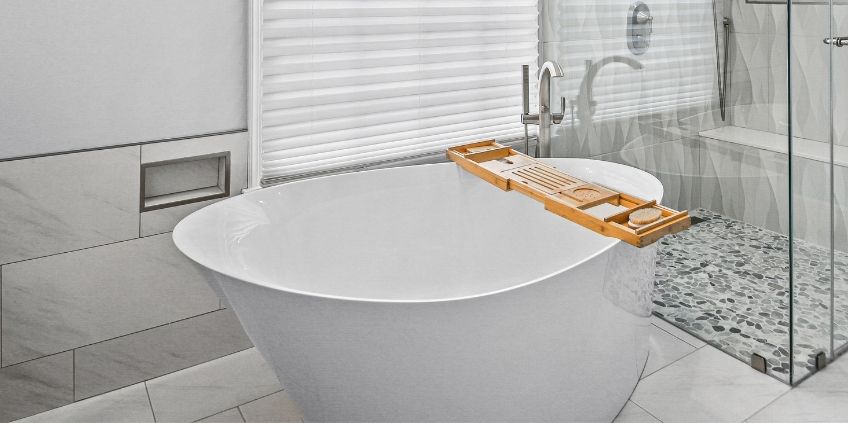
If you're dreaming of a spa-like retreat or a tub that makes your guests, say “wow,” a freestanding tub might be your best bet. It’s sculptural, elegant, and often becomes the focal point of the room — especially when placed near a window, under a chandelier, or opposite the door.
Freestanding tubs come in a wide variety of shapes — oval, boat, egg, square — and in materials like:
- Acrylic or fiberglass (lightweight and affordable)
- Cast iron or copper (great for heat retention)
- Solid surface or hand-carved stone (luxurious and modern)
Conversely, a built in tub is more understated, letting other design features like tile, lighting, or vanities shine. It works especially well in a smaller bathroom or in bathroom spaces for family use where you can align clean lines with maximum functionality.
3. Are You Going for a Specific Style?
Tubs can really influence the style of your bathroom:
- Freestanding tubs work beautifully in both modern and traditional design styles. A sleek, oval standalone tub suits a minimalist home, while a clawfoot tub or pedestal tub brings vintage charm.
- Built-in tubs are a bit like design chameleons. Whether your bathroom style is rustic, classic, or contemporary, built in bathtubs blend in seamlessly — and the materials you choose for the surrounding tile or paneling can really personalize the look.
Pro tip: mixing styles (like a modern freestanding tub in a more traditional space) can create a fun, unexpected twist!
4. How Much Space Do You Have?
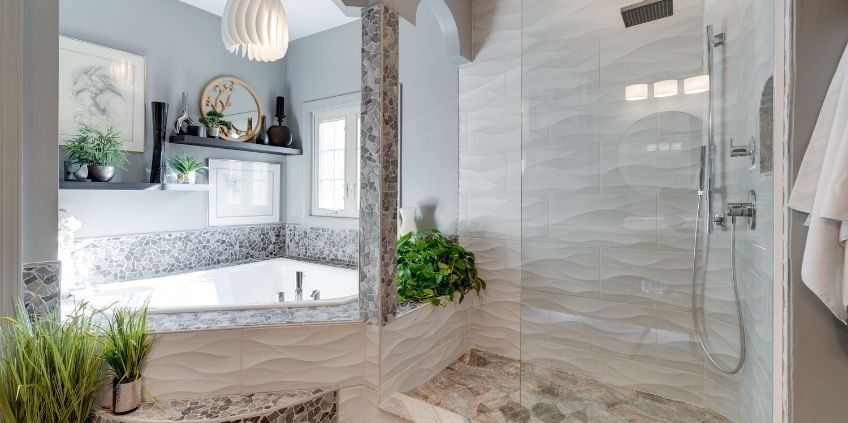
Your bathroom size plays a big role in determining the best tub for your space.
Freestanding tubs require more breathing room. Even if the bath tub itself is a standard size, you'll want clearance around it for safety, as well as visual balance and easier access to when cleaning.
Built-in tubs are generally more space-saving, especially in a small bathroom or homes where every inch counts in a bathroom layout and where the built-in tub can be paired with a shower. However, some styles can take up considerable space, particularly when angled neatly into a corner.
If you’re working with a compact layout but love the freestanding look, a smaller, streamlined model may still be possible. It may help the room feel more open despite your bathroom size.
5. What About Budget and Installation?
Here's what to keep in mind:
- Freestanding tubs often cost more upfront, especially with heavier or custom materials. The installation can be easier, but can be impacted by plumbing costs, particularly when plumbing needs to be moved or new types of fixtures, like a floor-mounted faucet or others, are selected.
- Built-in tubs are usually more affordable to buy. However, installation can be more complex depending on the placement, particularly in corners. You’ll need to factor in the cost of building and finishing the surrounding structure in addition to plumbing costs and material costs like tile or stone.
Depending on the size of your bathroom, either option can work in most cases. Just be sure to identify and plan for all parts and work needed with whichever tub you choose.
6. Is the Tub Going to Work for You or Your Whole Family?
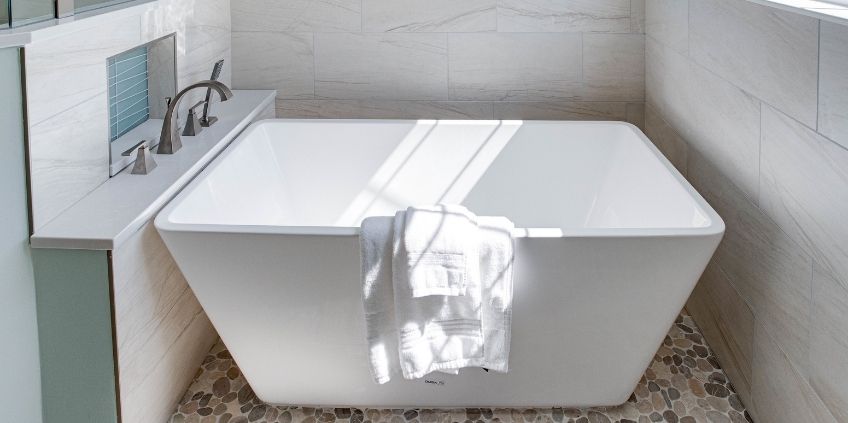
Freestanding tubs look dreamy on Pinterest. But unless it is your private getaway in your new dream bathroom, think about who’s going to be using it:
- Do you have young kids you’ll need to bathe?
- Will aging family members need easy access?
- Is this the main tub in your home, or a second bathroom?
Freestanding tubs can be harder to get in and out of, and their height can make bath time tricky with little ones or aging family members.
Built-in tubs tend to be easier and more practical for everyday family life. A lower edge, built-in surround, or step can make a big difference in comfort and accessibility — both now and in the future.
7. What About Comfort and Soaking Experience?
Comfort is personal. That’s why it’s smart to “test-drive” a tub in a showroom if possible:
- Can you stretch out fully?
- Does the size of the tub support you comfortably?
- Are the faucet and drain out of the way?
- Is the material warm to the touch?
It is smart to research how well any tub holds heat. Materials like cast iron and stone stay warmer longer, while acrylic and fiberglass may cool down faster. Some built in tubs come insulated for even better heat retention.
8. Is Maintenance a Factor for You?
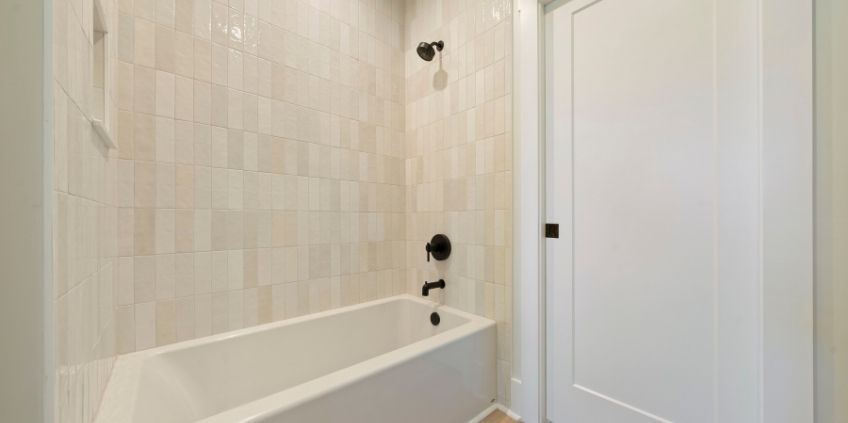
Freestanding tubs look stunning — but you’ll need to keep all sides clean, as well as the underneath if it’s raised on legs. Placement away from walls will make cleaning behind it a bit easier.
Built-in tubs are often easier to maintain, though the surround material (tile grout, wood paneling, glass doors) can add to your cleaning checklist.
Material matters here, too:
- Acrylic is easy to clean but prone to scratching.
- Enamel may chip or rust.
- Spa tubs require more frequent cleaning routines.
And if you’re considering a whirlpool tub with jets, know that it will need regular cleaning cycles to stay hygienic.
Final Thoughts: Which Tub is Right for You?
Here’s a quick comparison to help you decide:
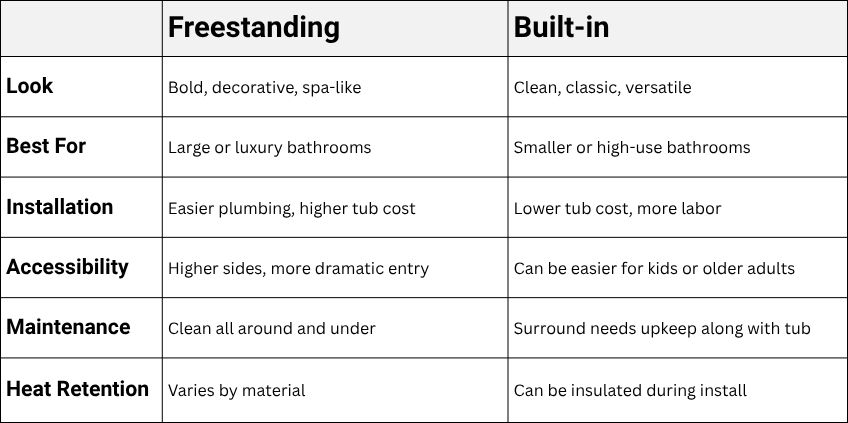
Still Not Sure? We Can Help!
The perfect tub decision depends on your space, your lifestyle, and your design goals. Whether you’re planning your own bathroom renovation or helping your clients make smart decisions for their bathroom design, understanding the pros and cons of each bathtub style ensures a more informed, confident investment.
At Reico Kitchen & Bath, our design experts can help you compare options, explore layouts, and pick the perfect fit for any bathroom. Whether you’re shopping for that must-have statement tub or exploring tub optoins along with other bath products like vanities, tile, or fixtures for your bathroom remodeling project, we can help.
Visit a showroom near you or schedule a design consultation to start planning your dream bathroom.
